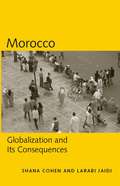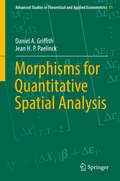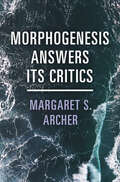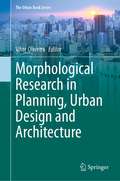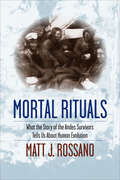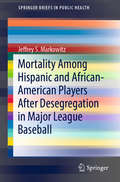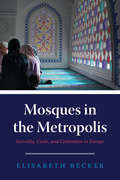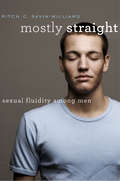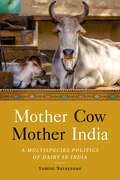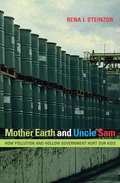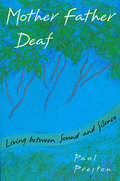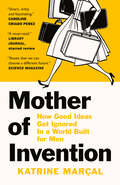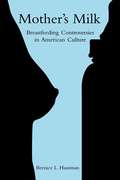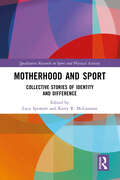- Table View
- List View
Mornings at the Stanton Street Shul: A Summer on the Lower East Side
by Jonathan BoyarinThis story of one of the last remaining synagogues in the historic neighborhood and its congregation is &“as absorbing as a good cinema verité documentary&” (Booklist). On New York&’s Lower East Side, a narrow building, wedged into a lot designed for an old-law tenement, is full of clamorous voices—the generations of the dead, who somehow contrive to make their presence known, and the newer generation, keeping the building and its memories alive and making themselves Jews in the process. In this book, Jonathan Boyarin, at once a member of the congregation and a bemused anthropologist, follows this congregation of &“year-round Jews&” through the course of a summer during which its future must once again be decided. Famous as the jumping off point for millions of Jewish and other immigrants to America, the neighborhood has recently become the hip playground of twentysomething immigrants to the city from elsewhere in America and from abroad. Few imagine that Jewish life there has stubbornly continued through this history of decline and regeneration. Yet, inside with Boyarin, we see the congregation&’s life as a combination of quiet heroism, ironic humor, lively disputes, and—above all—the ongoing search for ways to connect with Jewish ancestors while remaining true to oneself in the present. Mornings at the Stanton Street Shul is both a portrait of a historic neighborhood facing the challenges of gentrification, and a poignant, humorous chronicle of vibrant, imperfect, down-to-earth individuals coming together to make a community.
Morocco: Globalization and Its Consequences (Global Realities #Vol. 6)
by Shana Cohen Larabi JaidiCohen and Jaidi trace the development of contemporary Morocco in the Islamic world of North Africa, which is currently at the forefront of the clash between Western-style development and the politicized Islam that now pervades the Arab world. By applying globalization theory to detailed accounts of everyday life in an Arab society, the book is uniquely suited to students. Morocco in particular is a good place to look at this extremely important confrontation. It is among the most liberalized Islamic states, yet it is also in the midst of a revival of politicized Islam, which has its own globalizing agenda. The authors detail how this clash pervades Moroccan culture and society, and what it can tell us about the effects of globalization on the Arab world. Morocco is extremely close to the West in terms of physical proximity, and it is a favoured spot for Western tourists. Yet its closest neighbours in social terms are Algeria, Libya, and Tunisia, all of which have directly experienced the effects of politicized Islam in the last quarter century.
Morphisms for Quantitative Spatial Analysis (Advanced Studies In Theoretical And Applied Econometrics Ser. #51)
by Daniel A. Griffith Jean H. PaelinckThis book treats the notion of morphisms in spatial analysis, paralleling these concepts in spatial statistics (Part I) and spatial econometrics (Part II). The principal concept is morphism (e.g., isomorphisms, homomorphisms, and allomorphisms), which is defined as a structure preserving the functional linkage between mathematical properties or operations in spatial statistics and spatial econometrics, among other disciplines. The purpose of this book is to present selected conceptions in both domains that are structurally the same, even though their labelling and the notation for their elements may differ. As the approaches presented here are applied to empirical materials in geography and economics, the book will also be of interest to scholars of regional science, quantitative geography and the geospatial sciences. It is a follow-up to the book “Non-standard Spatial Statistics and Spatial Econometrics” by the same authors, which was published by Springer in 2011.
Morphogenesis Answers Its Critics
by Margaret S. ArcherMargaret S. Archer was a leading social theorist who was highly influential in the development of critical realism. Her work covered many strands of realist social theory including what has become known as the M/M (morphostatic/morphogenetic) approach. Morphogenesis refers to social processes that amplify deviations from a given social form or state (positive feedback) and morphostasis to ones that restore or reproduce these characteristics through negative feedback. The M/M approach is intended to be of practical and interdisciplinary use in the analysis of stability and change at all levels of the social order. It differs from approaches by popular theorists such as Anthony Giddens, Ulrich Beck and Pierre Bourdieu, who conflated 'structure and agency' by conceptualizing them as 'mutually constitutive'. In this book Professor Archer defends her explanatory framework through a series of responses to critics of her work and presents her reflections on debates surrounding it.
Morphological Research in Planning, Urban Design and Architecture (The Urban Book Series)
by Vítor OliveiraThis book is about the relation between scientific research and professional practice on the built environment. The physical form of cities is structured in different elements of urban form. Each of these elements, and the way they are combined into distinct patterns, is shaped by various agents and processes of change. Planning, urban design and architecture are practice-oriented activities that have a significant impact on these elements. Yet, this ‘action’ on the physical form if cities tends to be separated from scientific ‘knowledge’ on this complex object. In fact, none of these activities is strongly related to urban morphology, the science of urban form. There are many reasons for this gap. One of the reasons is the lack of significant examples of how the bridging process can happen. The book addresses this specific issue. It gathers a number of cases, developed in the last years in different geographical contexts – from Latin America to Eastern Asia – that exemplify how to move from scientific research to professional practice. Each case, or set of cases, is presented in one chapter. The first part of each chapter presents the morphological view of his/her author(s) on the process of city building; the second part exemplifies how this author moves from reading to design.
Mortal Rituals: What the Story of the Andes Survivors Tells Us About Human Evolution
by Matt RossanoOn December 21, 1972, sixteen young survivors of Uruguayan Air Force Flight 571 were rescued after spending ten weeks stranded at the crash site of their plane, high in the remote Andes Mountains. The incident made international headlines and spawned several best-selling books, fueled partly by the fact that the young men had resorted to cannibalism to survive. Matt Rossano examines this story from an evolutionary perspective, weaving together findings and ideas from anthropology, psychology, religion, and cognitive science. During their ordeal, these young men broke "civilized" taboos to fend off starvation and abandoned "civilized" modes of thinking to maintain social unity and individual sanity. Through the power of ritual, the survivors were able to endure severe emotional and physical hardship. Rossano ties their story to our story, seeing in the mortal rituals of this struggle for survival a reflection of what it means to be human.
Mortal Secrets: Freud, Vienna, and the Discovery of the Modern Mind
by Frank TallisA chronicle of Vienna's Golden Age and the influence of Sigmund Freud on the modern world by a clinical psychologist whose mystery novels form the basis of PBS's Vienna Blood series. Some cities are like stars. When the conditions are right, they ignite, and burn with such fierce intensity that they outshine every other city on the planet. Vienna was one such city and, at the beginning of the twentieth century, was the birthplace of the modern mind and the way we live today. Long coffee menus and celebrity interviews are Viennese inventions. ‘Modern’ buildings were appearing in Vienna long before they started appearing in New York and the idea of practical modern home design originated in the work of Viennese architect Adolf Loos. The place, however, where one finds the most indelible and profound impression of Viennese influence is inside your head. How we think about ourselves has been largely determined by Vienna’s most celebrated resident, Sigmund Freud.In Mortal Secrets, Frank Tallis brilliantly illuminates Sigmund Freud and his times, taking readers into the mind of one of the most influential thinkers of the twentieth century, chronicling the evolution of psychoanalysis and opening up Freud’s life to embrace the Vienna he lived in and the lives of the people he mingled with from Gustav Klimt to Arnold Schönberg, Egon Schiele to Gustav Mahler. Mortal Secrets is a thrilling book about a heady time in one of the world’s most beautiful cities and its long shadow that extends through the twentieth century up until the present day.
Mortality Among Hispanic and African-American Players After Desegregation in Major League Baseball (SpringerBriefs in Public Health)
by Jeffrey S. MarkowitzThis compelling book examines mortality risk among former Hispanic and African-American players in Major League Baseball (MLB) during the 40-year period following desegregation in the League. Analyzing a variety of biological, cultural, social, and environmental factors, the author illustrates the potential health effects of racial disparities on these elite athletes and fills a significant gap in the mortality literature.Included in the coverage:The history and evolution of professional baseball in both the United States and Latin AmericaLiterature and statistical reviews of racial and ethnic inequalities in mortality in the US general populationOverview and evaluation of methodologies used to statistically analyze mortality risk in this professional-athlete populationImplications and applications of research findings related to Hispanic and African-American MLB-player mortalityA unique perspective on a pressing public health issue, Mortality Among Hispanic and African-American Players After Desegregation in Major League Baseball is a salient read for public health professionals including epidemiologists, medical professionals, and social scientists, as well as athletes, historians, and those with broad interest in African American and Latino health.
Mortgage Lending, Racial Discrimination and Federal Policy (Routledge Revivals)
by John Goering Ron WienkFirst published in 1997, this volume features a wealth of contributions discussing mortgage lending discrimination and the role of the FHA, fair lending enforcement and the Decatur case, along with the future of mortgage discrimination research. This key civil rights debate in the wake of the Fair Housing Act 25 years prior is evaluated and clarified through rigorous review of fair lending research, applied projects and enforcement activities to date. It argues forcefully that the right to take out a mortgage to buy a home should be conditioned only upon one’s credit worthiness and not on one’s race or ethnic group.
Morton Deutsch: A Pioneer in Developing Peace Psychology
by Peter T. Coleman Morton DeutschCommemorating Morton Deutsch's 95th birthday, this book presents ten major texts by this highly respected social psychologist on war and peace. This first volume presents Deutsch in his role as a leading social science activist on issues of war and peace - writing papers, making speeches and participating in demonstrations. After serving in the U. S. Air Force during World War II and being awarded two Distinguished Flying Cross medals, as a psychologist he was determined to work for a more peaceful world. Influenced by Kurt Lewin, who believed that nothing was as practical as a good theory, Deutsch pursued theoretical work on such issues as cooperation-competition, conflict resolution and social justice with regard to issues of war and peace. As President of the Society for the Study of Peace, Conflict and Violence, the Society for the Psychological Study of Social Issues and the International Society of Political Psychology, he helped to foster social science efforts to make for a more peaceful world.
Moscow's Evolution as a Political Space: From Yuri Dolgorukiy to Sergei Sobyanin
by Marina Glaser Ivan KrivushinThe book aims to trace and explain the historical evolution of Moscow, the capital of the Tsardom of Russia, Soviet Union and Russian Federation, as a political entity and political community, and to understand what place Moscow occupied within the Russian political space and what role it played in Russian political life for centuries until 2018. The authors consistently examine the dramatic political history of the contemporary Russian capital in the Moscow (13th – 17th centuries) and St. Petersburg (18th – 19th centuries) epochs, in the Soviet period, in the post-Soviet era, and identify its key points and the most pivotal events.
Mosques in the Metropolis: Incivility, Caste, and Contention in Europe
by Elisabeth BeckerMosques in the Metropolis offers a unique look into two of Europe’s largest mosques and the communities they support. Elisabeth Becker provides a complex picture of Islam in Europe at a particularly fraught time, shedding light on both experiences of deep and enduring marginalization and the agency of Muslim populaces. She balances individual Muslim voices with the historical and structural forces at play, revealing, in all their complexity, the people for whom the mosques are centers of religion and community life. As her interlocutors come to life in the pages, the metropolis emerges as a space alternative to the nation in which they can contend with degrading images of Islam and Muslims. Ultimately Becker insists that caste is a crucial lens through which to view Muslims in Europe, and through this lens she critiques what she perceives as the failures of European pluralism. To amplify her point, she brings Jewish history and twentieth-century Jewish thought into the conversation directly, drawing on scholars such as Walter Benjamin, Zygmunt Bauman, and Hannah Arendt to describe both Jewish and Muslim life and marginality. By challenging Eurocentric notions, from “progress” to “civility,” “tolerance” to “freedom” and “equality, what is at stake, Becker insists, is the possibility of a truly plural Europe.
Mosques in the Metropolis: Incivility, Caste, and Contention in Europe
by Elisabeth BeckerMosques in the Metropolis offers a unique look into two of Europe’s largest mosques and the communities they support. Elisabeth Becker provides a complex picture of Islam in Europe at a particularly fraught time, shedding light on both experiences of deep and enduring marginalization and the agency of Muslim populaces. She balances individual Muslim voices with the historical and structural forces at play, revealing, in all their complexity, the people for whom the mosques are centers of religion and community life. As her interlocutors come to life in the pages, the metropolis emerges as a space alternative to the nation in which they can contend with degrading images of Islam and Muslims. Ultimately Becker insists that caste is a crucial lens through which to view Muslims in Europe, and through this lens she critiques what she perceives as the failures of European pluralism. To amplify her point, she brings Jewish history and twentieth-century Jewish thought into the conversation directly, drawing on scholars such as Walter Benjamin, Zygmunt Bauman, and Hannah Arendt to describe both Jewish and Muslim life and marginality. By challenging Eurocentric notions, from “progress” to “civility,” “tolerance” to “freedom” and “equality, what is at stake, Becker insists, is the possibility of a truly plural Europe.
Mosques in the Metropolis: Incivility, Caste, and Contention in Europe
by Elisabeth BeckerMosques in the Metropolis offers a unique look into two of Europe’s largest mosques and the communities they support. Elisabeth Becker provides a complex picture of Islam in Europe at a particularly fraught time, shedding light on both experiences of deep and enduring marginalization and the agency of Muslim populaces. She balances individual Muslim voices with the historical and structural forces at play, revealing, in all their complexity, the people for whom the mosques are centers of religion and community life. As her interlocutors come to life in the pages, the metropolis emerges as a space alternative to the nation in which they can contend with degrading images of Islam and Muslims. Ultimately Becker insists that caste is a crucial lens through which to view Muslims in Europe, and through this lens she critiques what she perceives as the failures of European pluralism. To amplify her point, she brings Jewish history and twentieth-century Jewish thought into the conversation directly, drawing on scholars such as Walter Benjamin, Zygmunt Bauman, and Hannah Arendt to describe both Jewish and Muslim life and marginality. By challenging Eurocentric notions, from “progress” to “civility,” “tolerance” to “freedom” and “equality, what is at stake, Becker insists, is the possibility of a truly plural Europe.
Mostly Straight: Sexual Fluidity among Men
by Ritch C. Savin-WilliamsA growing number of young men today say they are “mostly straight” and yet feel a slight but enduring desire for men. Ritch Savin-Williams explores the stories of 40 mostly straight young men to help us understand the biological, psychological, and cultural forces that are loosening the sexual bind many boys and young men experience.
Mother Cow, Mother India: A Multispecies Politics of Dairy in India (South Asia in Motion)
by Yamini NarayananIndia imposes stringent criminal penalties, including life imprisonment in some states, for cow slaughter, based on a Hindu ethic of revering the cow as sacred. And yet India is among the world's leading producers of beef, leather, and milk, industries sustained by the mass slaughter of bovines. What is behind this seeming contradiction? What do bovines, deemed holy in Hinduism, experience in the Indian milk and beef industries? Yamini Narayanan asks and answers these questions, introducing cows and buffaloes as key subjects in India's cow protectionism, rather than their treatment hitherto as mere objects of political analysis. Emphasizing human–animal hierarchical relations, Narayanan argues that the Hindu framing of the cow as "mother" is one of human domination, wherein bovine motherhood is simultaneously capitalized for dairy production and weaponized by right-wing Hindu nationalists to violently oppress Muslims and Dalits. Using ethnographic and empirical data gathered across India, this book reveals the harms caused to buffaloes, cows, bulls, and calves in dairying, and the exploitation required of the diverse, racialized labor throughout India's dairy production continuum to obscure such violence. Ultimately, Narayanan traces how the unraveling of human domination and exploitation of farmed animals is integral to progressive multispecies democratic politics, speculating on the real possibility of a post-dairy society, based on vegan agricultural policies for livelihoods and food security.
Mother Earth and Uncle Sam
by Rena I. SteinzorIn this compelling study, Rena Steinzor highlights the ways in which the government, over the past twenty years, has failed to protect children from harm caused by toxic chemicals. She believes these failures--under-funding, excessive and misguided use of cost/benefit analysis, distortion of science, and devolution of regulatory authority--have produced a situation in which harm that could be reduced or eliminated instead persists. Steinzor states that, as a society, we are neglecting our children's health to an extent that we would find unthinkable as individual parents, primarily due to the erosion of the government's role in protecting public health and the environment. At this pace, she asserts, our children will inherit a planet under grave threat. We can arrest these developments if a critical mass of Americans become convinced that these problems are urgent and the solutions are near at hand. By focusing on three specific case studies--mercury contamination through the human food chain, perchlorate (rocket fuel) in drinking water, and the effects of ozone (smog) on children playing outdoors--Steinzor creates an analysis grounded in law, economics, and science to prove her assertions about the existing dysfunctional system. Steinzor then recommends a concise and realistic series of reforms that could reverse these detrimental trends and serve as a blueprint for restoring effective governmental intervention. She argues that these recommendations offer enough material to guide government officials and advocacy groups toward prompt implementation, for the sake of America's--and the world's--future generations.
Mother Father Deaf: Living Between Sound and Silence
by Paul Preston“Mother father deaf” is the phrase commonly used within the Deaf community to refer to hearing children of deaf parents. These children grow up between two cultures, the Hearing and the Deaf, forever balancing the worlds of sound and silence. Paul Preston, one of these children, takes us to the place where Deaf and Hearing cultures meet, where families like his own embody the conflicts and resolutions of two often opposing world views. Based on 150 interviews with adult hearing children of deaf parents throughout the United States, Mother Father Deaf examines the process of assimilation and cultural affiliation among a population whose lives incorporate the paradox of being culturally “Deaf” yet functionally hearing. It is rich in anecdote and analysis, remarkable for its insights into a family life normally closed to outsiders.
Mother India's Children: Meeting Today's Generation in India
by Edward RiceYoga, books of meditation and the music of India are becoming increasingly popular in the United States, particularly among young people. To discover how young people who have lived within this other culture think, Edward Rice, the author and photographer of this book, spent time in India talking with teenagers. In these "interviews" -cool, casual raps by a gifted observer -the author asked all kinds of questions, and came up with an intense and personal portrait of a country; revealed with an immediacy and intimacy that will surprise most American readers, on either side of the generation gap. TRADITIONAL INDIA A young Muslim girl, almost too shy to speak; a Brahmin wife, married at 14; a teenage guru fast becoming an expert on the 4,000 year old prayers and chants taught by the Vedas. BIG CITY INDIA Upper class teenage rebels, office workers, students, young Sikhs and Parsis: castes and classes juggled together in crowded cities. CHANGING INDIA A Muslim girl who defies tradition by entering a beauty contest-and wins; an elephant boy from the jungles; students in villages and towns trying to find a balance between India's past and India's present. People talking, people walking, people caught by the special magic in a photograph; a time and culture at once summed up and left mysterious: Mother India's Children.
Mother Tongue Prestige: The Sociolinguistics of Privilege in Urban Middle-Class Education in India
by Jessica Sujata ChandrasThis book studies the intersection of language and social privilege in education in India. Drawing on rich ethnographic detail and primary data, it introduces a conversation of privilege, specifically contemporary configurations of caste and socioeconomic class in India, to the fields of South Asian studies and sociolinguistic educational studies. The author examines how and why education at the pre-primary, secondary, and higher education levels in India remains largely segregated by socioeconomic class and caste through the lens of language. She advances fields of study of multilingual education, language ideologies, and complexities between language and identity to contribute to work on language and privilege in education by providing a novel and contemporary case from India. The book also critiques contemporary caste configurations in India that uphold urban middle-class Brahmins as the socially privileged purveyors of social and linguistic norms. Mother Tongue Prestige parses out threads of motivation, perceptions of education, and aspirations tied to language use and learning that shape generations of students in an educational system preparing them for a globalized workforce and urban, multilingual livelihoods in India and abroad. It will be indispensable for students and researchers of education, language, sociology, sociology of education, linguistics, sociolinguistics, South Asian studies.
Mother of Invention: How Good Ideas Get Ignored in an Economy Built for Men
by Katrine MarcalAn illuminating and maddening examination of how gender bias has skewed innovation, technology, history and work.It all starts with a rolling suitcase. The wheel was invented some 5,000 years ago, and the modern suitcase in the mid-nineteenth century, but it wasn&’t until the 1970s that someone successfully married the two. What was the hold up? For writer and journalist Katrine Marçal, the answer is both shocking and simple: because "real men" carried their bags, no matter how heavy. There were rolling suitcases before the '70s, but they were marketed as a niche product for (the presumably few) women travelling alone, and the wheeled suitcase wasn't "invented" until it was no longer threatening to masculinity. Mother of Invention draws on this example and many others, from electric cars to tech billionaires, to show how gender bias stifles the economy and holds us back. Our traditional notions about men and women have delayed innovations, sometimes by hundreds of years, and have distorted our understanding of our history. While we talk about the Iron Age and the Bronze Age, we might as well talk about the Ceramic Age or the Flax Age, since these technologies were just as important. But inventions associated with women are not considered to be technology in the same way. Katrine Marçal&’s Mother of Invention is a fascinating examination of business, technology, and innovation through a feminist lens. Marçal takes us on a tour of the global economy, arguing that gendered assumptions dictate which businesses get funding, how we value work, and how we trace human progress. And it carries a powerful message: If we upend our biases, we can unleash our full potential, tackling climate change and wielding technology to become more human, rather than less.
Mother's Milk: Breastfeeding Controversies in American Culture
by Bernice L. HausmanMother's Milk examines why nursing a baby is an ideologically charged experience in contemporary culture. Drawing upon medical studies, feminist scholarship, anthropological literature, and an intimate knowledge of breastfeeding itself, Bernice Hausman demonstrates what is at stake in mothers' infant feeding choices--economically, socially, and in terms of women's rights. Breastfeeding controversies, she argues, reveal social tensions around the meaning of women's bodies, the authority of science, and the value of maternity in American culture. A provocative and multi-faceted work, Mother's Milk will be of interest to anyone concerned with the politics of women's embodiment.
Mother-Work: Women, Child Welfare, and the State, 1890-1930 (Women, Gender, and Sexuality in American History)
by Molly Ladd-TaylorEarly in the twentieth century, maternal and child welfare evolved from a private family responsibility into a matter of national policy. Molly Ladd-Taylor explores both the private and public aspects of child-rearing, using the relationship between them to cast new light on the histories of motherhood, the welfare state, and women's activism in the United States. Ladd-Taylor argues that mother-work, "women's unpaid work of reproduction and caregiving," motivated women's public activism and "maternalist" ideology. Mothering experiences led women to become active in the development of public health, education, and welfare services. In turn, the advent of these services altered mothering in many ways, including the reduction of the infant mortality rate.
Motherhood and Postnatal Depression
by Pranee Liamputtong Carolyn WestallGlobally, postnatal depression (PND) is a growing public health problem. PND affects 10 to 15% of women in Western society. It caused by a combination of biological, psychological and social factors. Two models have attempted to define and explain PND; the biomedical and the sociological models. The traditional biomedical model views PND as a medical condition which implies there is individual pathology and abnormality. Whilst the biomedical model has been the dominant model in treating PND, it has been criticized by feminist sociologists and psychologists for its rigidity in defining and explaining PND. In contrast, the psychosocial model of health acknowledges the biological factors that impact on emotional well-being, but places more emphasis on the personal and social factors that impact on emotional well-being, but places more emphasis on the personal and social factors that contribute to depressive symptoms such as gender, poverty, social disadvantage and social class. The central argument throughout this book is the importance of support before and after the birth for women's emotional well-being. This book will also include women's journeys through pregnancy, childbirth, motherhood, postnatal depression, and resolution. To date, literature has focused on women's lived experiences of PND rather than their personal journeys through pregnancy, childbirth and early motherhood. Additionally, the adjustment to fatherhood has received less attention. For example, little is known about the impact of postnatal depression on the partner, what support partners offer when women with the intention to fill the gap in knowledge of cultural and social issues relating to pregnancy, childbirth, and motherhood for woman who were diagnosed with, and had resolved, PND.
Motherhood and Sport: Collective Stories of Identity and Difference (Qualitative Research in Sport and Physical Activity)
by Lucy SpowartAlthough sport participation decreases on average for women once they become mothers, female athletes from the recreational, to the competitive, to the elite level have demonstrated that motherhood does not signal the end of sport engagement and athletic identities, or career and leadership roles. This is the first book to offer an in-depth examination of the nexus of women, sport and culture within the context of motherhood, uncovering new narratives that raise the profile of non-conformist performances. The book brings together international researchers using innovative and rigorous qualitative methods to show how sport affords or constrains women’s agency to devise, negotiate and live alternative versions of motherhood in and through sport. Presenting stories of sporting mothers in contexts including martial arts, leisure swimming, recreational running, triathlon and climbing, the book explores the shifting meaning and practices of motherhood across social, cultural and media/digital landscapes. Deliberately challenging taken-for-granted ways of thinking about motherhood and sport, this book is fascinating reading for anybody with an interest in the socio-cultural study of sport, gender and sport, women’s studies, sport coaching, sport leadership, sport development, or qualitative and digital research methods.

